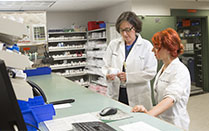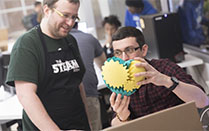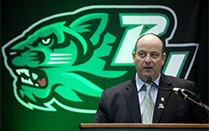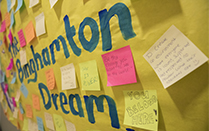Binghamton University President Harvey Stenger's Road Map Quarterly Report - March 31, 2017
The start of spring is always a turning point at the University. Gray skies slowly give way to blue, the temperature begins to warm and the pace picks up as students turn their attention to the crush of schoolwork that marks the least weeks of the semester. This quarter we are especially looking forward to the change of season, as record-breaking snows inundated the campus in March, and students endured another tragedy in the death of one of their peers. Despite these difficulties, the overall tenor of the quarter was positive, with all areas of the campus seeing noteworthy successes.
By far, the most difficult event of the past three months was the accidental death of freshman student Conor Donnelly on March 18, at an off-campus site. Conor was a bright, talented young man from Pearl River, N.Y. who was well-liked and respected by his fellow students. I, along with a number of other University staff and administrators, have reached out to the family, knowing that there is little we could say to alleviate their suffering. Dozens of students saw the accident occur, and we have provided counseling and other services to students who have been affected by his death. We called on faculty to arrange for students whose academics may have suffered as a result of his death. I also called upon faculty, staff and students to take time to encourage students to make safe choices and look after their friends when socializing.
SNOW EMERGENCY
I also urged faculty to be flexible regarding lectures and grades following the massive snowstorm that hit our campus in mid-March. Given the structure of the academic calendar, the timing of the storm was relatively favorable — most faculty had already concluded mid-term exams, so few students had tests to make up. The Center for Learning and Teaching also offers several tools that allow faculty to record and post lectures and other course materials that students might have missed.
The storm itself was remarkable, dropping a record-breaking 31 inches of snow — the most ever in a single storm for the campus and Binghamton area. Given the storm’s intensity, classes were canceled for two days. Conditions were especially bad the first day, and while the campus roads were largely cleared by the following morning, a state of emergency meant that students, faculty and staff could not travel from their residences, except for 600 or so “essential” employees who helped keep the campus up and running. Particularly impressive was the work of our physical facilities staff who worked nearly non-stop to keep our roads and walkways clear.
CONSTRUCTION AND UDC REIMBURSEMENT
The weather hasn’t deterred progress on several major projects for the University. At our new Health Sciences Campus in Johnson City, structural steelwork has been completed on our new School of Pharmacy and Pharmaceutical Sciences building. External sheathing is going up and internal mechanical, electrical and plumbing systems are being installed, with a fall 2018 opening scheduled. Meanwhile, asbestos abatement and exterior renovation is beginning at 48 Corliss Ave., where the Decker School of Nursing will be relocated. In addition, both our Smart Energy Research and Development Facility and the Southern Tier Incubator are nearing completion, with tenants for the latter due to move in in the beginning of April.
Also in Binghamton, our University Downtown Center (UDC), home of our College of Community and Public Administration (CCPA), received some good, though very long-delayed news. U.S. Sen. Charles “Chuck” Schumer, Senate minority leader, was on campus to announce the release of funds due the University from the Federal Emergency Management Administration (FEMA). Flooding in 2011 had badly damaged the Downtown Center’s infrastructure and forced the closure of the facility for nearly a year. The University applied for over $3 million in FEMA reimbursement, but due to an error on FEMA’s part, we only received around $700,000 at the time. Schumer doggedly assisted us in trying to recoup the missing funds, and finally, after over five years, he shook loose about $2 million from FEMA. These funds will be used to support the Living Building at Nuthatch Hollow and to help build a new welcome center on campus to help us manage and promote the campus to the more than 250,000 visitors we have each year. Schumer is working to help us recoup an additional $700,000 we spent to recover from the flood.
The CCPA itself is adding a new department, as the Graduate School of Education (GSE) will be merged into CCPA as a separate department. We’ve recently begun the process of integrating the two schools, following the February ratification of the proposal by the Faculty Senate.
While this is a significant change in the campus structure, we believe it is a natural fit and that the time is right. Interim GSE Dean Susan Strehle will be ending her term as dean soon and there is a long institutional history between the areas of education and human development. Much of the research and work being done by CCPA faculty and staff is in the education field, including the Binghamton University Community Schools (work being done through the Broome County Promise Zone and new initiatives in Elmira County) and CCPA’s Center for Family, School and Community Partnerships. Dean Laura Bronstein, Dean Strehle and other members of the deans’ offices/administration have been working closely on transitioning responsibilities and laying out plans once the merger occurs, with the appointment of a new Department of Education chair pending.
DONATIONS AND DONOR RECOGNITION
One of the things that motivates our deans and vice presidents is the support they receive from alumni and others who are eager to see their programs grow and develop. What makes them happiest, though, is when these supporters step forward with financial support to ensure that students and faculty have the resources they need to learn, teach and conduct research and scholarship at the highest levels.
The administration has been working very closely with our Advancement Division to match donors with academic and other projects that reflect the donor’s interests and will propel the campus forward. This quarter saw several significant donations that support undergraduate and graduate student learning, cutting-edge scholarship and also foster career success for our graduates. Among these transformative gifts are:
• An anonymous gift establishing the Institute for Genocide and Mass Atrocity Prevention. Arranged by Owen Pell ’80, this scholarly center will offer undergraduate and master’s degrees, as well as graduate certificates with the goal of educating professionals who will work to identify areas of potential genocide and work to stem atrocities. This world-changing work will have a profound global impact. This is a first-of-a kind program that unites scholars in the social sciences and partners in NGOs around the world to try to identify places where mass political violence is occurring or about to occur and to work to break the chains of events and institutions that allow them to happen.
• A donation from Professor Emeritus Tsuming Wu and his wife, Grace Chin-Fa, to establish a fellowship for graduate students pursuing doctoral degrees in mathematics or the natural sciences.
• Another anonymous seven-figure gift established an endowed professorship in the Thomas J. Watson School of Engineering and Applied Science in memory of Distinguished Professor George Klir.
• The largest gift in the Education Opportunity Program’s history from retired New York City Education Department employee Mabel Payne ’71.
What these gifts show me is that our advancement team is doing its work very well — helping us identify prospects, pair them prospects with important academic and research objectives and steward resources that strengthen the campus. In fact, campus donations increased by 27 percent in 2015-16, to $11.5 million, and donations for 2016-17, which have not been completely tallied, are 20 percent ahead of that.
Of course, colleges and universities, particularly those that compete at the NCAA Division I level, also encourage support for our athletics teams. Such support helps build athletic success and name recognition, and we’ve been very successful in this regard this quarter. Four Binghamton coaches — volleyball coach Glenn Kiriyama, women’s basketball coach Linda Cimino, softball coach Michelle Burrell and baseball coach Tim Sinicki were each named conference Coach of the Year in their respective sports. And I am glad to recognize as well Binghamton Athletics Director Patrick Elliott, who was named an Under Armour Athletics Director of the Year, NCAA Division I-AAA (non-football).
But donor support for athletics does more than build winning teams —it helps our student-athletes succeed in the classroom. No event demonstrates this better than our annual Celebrating Women’s Athletics Luncheon, now in its 12th year. This event has grown remarkably over the years — from fewer than 50 people attending, to welcoming more than 650 people this year to a talk by former WNBA player and Olympic gold-winner Swin Cash. Since the luncheon’s inception, more than $300,000 has been raised to support an endowment that provides scholarships for female athletes.
Scholarship support helps students succeed in college and take the first steps in their professional careers. But what happens after that is also something that we worry about. Traditionally, many students graduate college with little or no financial awareness — how to maintain their bank accounts, how to invest for retirement and how to save for emergencies.
Fortunately, Binghamton is taking the lead in addressing this problem, thanks to support provided by Visions Federal Credit Union, which established a Financial Wellness Center in our Fleishman Center for Career and Professional Development. The Financial Wellness Center, one of only a handful at American colleges or universities, is designed to help students learn to make good financial decisions and give them the tools they need before they leave college.
And speaking of finances, Binghamton students seem to be doing better than their peers, according to recent data in The New York Times. Binghamton graduates, at age 34, earn, on average $65,700 — about $5,000 more than their peers — placing Binghamton among the top 10 universities in New York and in the top 4 percent of the more than 2,100 colleges in the survey. And most significantly, Binghamton ranks #3 out of 25 selective public colleges in New York in terms of promoting social mobility.
At the end of March, the University recognized our graduate’s success, and their service to their communities at the University, at the Annual Alumni Recognition Awards Ceremony held in New York City. This year, we honored more than a dozen distinguished alumni — technology entrepreneurs, television leaders, financiers, educators and business leaders. Each has made significant contributions to our University, and more importantly, have significantly enhanced the quality of life, added to the quantity of knowledge and cultivated the highest standards of service and leadership. You may read about these exemplary alumni on our website.
ADMISSIONS AND ENROLLMENT TARGETS
Even as we celebrate the achievements of our past students, we welcome our next group of future alumni. The first quarter of the year is a time of excitement for high-school and transfer students who have applied to Binghamton, many of whom are now receiving notice of admission for next fall. This year, Binghamton received 33,156 freshman applications for just 2,600 seats, surpassing last year’s record number of applications. Nearly 9 percent (2,850) of freshman applicants are from a state other than New York. Out-of-state recruitment continues to be a top priority for the campus as it brings us great diversity, more national recognition and is critical for overall revenue; however, demographic shifts, particularly in the Northeast, have created an extremely competitive environment. We also are closely monitoring our international recruitment given policy changes in Washington. Our goal is to keep undergraduate enrollment steady, with a focus on academic quality and increasing student success.
We also are working hard to increase graduate enrollment, growing it by 28 percent in the past five years. With new academic programs such as master’s programs in public health and sustainable communities coming on line, and hard work by faculty and staff in existing programs, we should continue to grow by 150-200 graduate students, bringing us to around 3,850 graduate students in fall 2017. Here again, international recruitment is particularly challenging, as we don’t know if students from our big markets (India, China, etc.) will find the U.S. as attractive as they have in the past. Already, we are seeing a slight decline in graduate applications, but promisingly, we are seeing a higher rate of applicants commit to Binghamton.
Helping bring in more graduate students is our School of Pharmacy and Pharmaceutical Sciences (SOPPS) which recently was granted pre-candidate status by the Accreditation Council for Pharmacy Education (ACPE). This allowed the school to begin directly recruiting graduate students for next fall’s class, resulting in a major uptick in applications. We are very confident that we will hit our opening target of 90 students for our inaugural class, with very high quality.
BINGHAMTON IN THE CITY
We also met with dozens of prospective students at the second Annual Binghamton in the City week, highlighted by a group skate at the Bryant Park skating rink. Hosted by the Alumni Association, the event also included many alumni-employer visits, student and alumni networking opportunities, panel discussions and alumni gatherings. Binghamton in the City is one of our largest alumni outreach events, and helps raise the University’s visibility in one of the core regions for recruiting students and employing graduates. I believe that the residents who reside in the Metro New York region constitute one of the University’s most powerful assets — they are ambitious, motivated leaders in their fields who feel strongly about their Binghamton roots.
HARPUR DEAN SEARCH
Of course, what draws students to Binghamton is the quality of our academic programs. The deans of our schools play an important role in setting the academic agenda and ensuring that students receive an educational experience that is both comprehensive and forward looking. Given these responsibilities, I’m pleased to announce that Elizabeth Chilton, associate vice chancellor for research and engagement at the University of Massachusetts Amherst, will be joining the campus in July to serve as the dean of Harpur College of Arts and Sciences.
Having served as a professor of anthropology with a focus on Native American culture, she comes to Binghamton with additional experience as the director of the Center for Heritage & Society at the University of Massachusetts Amherst, an interdisciplinary research center across three academic colleges and eight academic departments. She also has served as department chair and associate dean for research in the College of Social and Behavioral Sciences at Amherst. In all these roles, she has shown an ability to work across disciplines, something that is very important for someone who is taking over a school with as many academic programs as Harpur has. I think she’s a very good fit with the University and will serve Harpur well.
STATE OF SUNY AND THE BUDGET
In January, I attended the SUNY Chancellor’s State of the University address. At the end of the academic year, she will step down after serving SUNY for the past seven years. Her address was pretty much a high-altitude view of the SUNY system, as is appropriate, though she did single out Binghamton for our successes with the Binghamton Advantage Program with SUNY Broome and Corning Community College. The big takeaway of her remarks was a proposal to develop a new SUNY Impact Foundation that would partner with the private sector to develop SUNY-wide initiatives.
All of SUNY is watching closely how budget negotiations are proceeding in Albany. Binghamton has been front and center during this process, as both Gov. Andrew Cuomo and Lt. Gov. Kathy Hochul visited campus over the past month to provide overviews of their budget proposal.
During his talk, Cuomo identified several projects for the region — including a plan to rebuild the section of Route 434 from the campus to the city of Binghamton. He also promoted economic development and infrastructure enhancement, and touted many of the Regional Economic Development Council and Upstate Revitalization Initiative investments in the Southern Tier.
But most anticipated is his proposal for Excelsior Scholarships that would provide free tuition to public colleges and universities for New York residents with family income under $125,000. If this is implemented, SUNY would be the first system in the nation to provide tuition costs beyond community college.
There are also indications that there will be increases in the critical maintenance funding for campuses, which was significantly reduced three years ago, though it is unclear how much will be finally appropriated. Currently, the budget was due to be finalized on April 1, though the governor and legislature required a few more days to come to agreement.
CONCERNS ABOUT CHANGES IN FEDERAL POLICY
In my last quarterly report, I indicated that students were concerned about possible changes in policy emanating from Washington, D.C. with a new administration in office. These concerns were prescient, as the administration announced changes to immigration policy and Title IX rules concerning the LGBTQ population. Two separate notices that targeted travelers from several nations in the Mideast impacted dozens of students and scholars on our campus before a court order stopped their implementation. Given the uncertainty caused by these proceedings, Provost Donald Nieman and I issued a statement urging students and scholars from the affected nations to forego travel, and to consult with our Office of International Student and Scholar Services for the latest information.
Binghamton is widely recognized as a leading internationalized institution, so we take these concerns very seriously. In discussing the bans with campus, local and national leaders, I have argued that they place significant burden on students and scholars and their families — preventing them from visiting their home countries and preventing them from participating in international conferences, research opportunities or job interviews that are crucial to their careers.
But more broadly, I am concerned about the damage that these orders do to the reputation of American higher education, of which Binghamton is a growing part. Already, colleges and universities are seeing declines in applications from overseas.
We also are hearing from students who are concerned about changes in policies regarding LGBTQ students, particularly following the recent revocation of the Office of Civil Rights guidelines for transgender students.
Valerie Hampton, director of our Division of Diversity, Equity and Inclusion and chief diversity officer, released a letter for the campus community reaffirming NYS protections for equality under the law, and noting the University’s efforts to support the LGBTQ community.
ROAD MAP
The Road Map Renewal that will update our strategic plan continues to make progress. The renewal is building on the existing structure of the Road Map, utilizing the same strategic priorities and the processes for identifying and implementing projects that have helped the campus develop over the past five years.
Nonetheless, I am expecting that there will be some path-breaking ideas and projects to come out of the renewal. We are looking for activities and initiatives that will move the campus forward in a time of change — changing resources, policies and priorities. With these limits in mind, we are looking to identify collaborative projects that will leverage our resources and have a broad impact on the University community.
Teams have been meeting weekly, and in some cases, even more frequently, to brainstorm and develop concrete proposals. We’ve encouraged the teams — which each align with one of our five strategic priorities — to share their proposals with each other to see where there is overlap with proposals so teams can work to combine them to increase efficiency and effectiveness. We’re under a very tight deadline — I’m looking forward to having proposals on my desk by the end of April. I can’t wait to see what the campus dreams up.
As you can see, it’s been a very eventful quarter. It seems they all are. That’s what makes being president of this great University so interesting.
Sincerely,

Harvey G. Stenger








